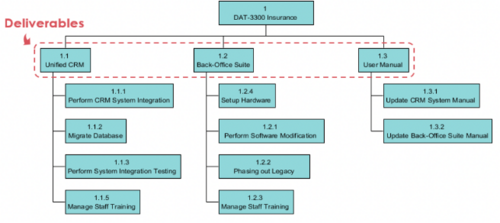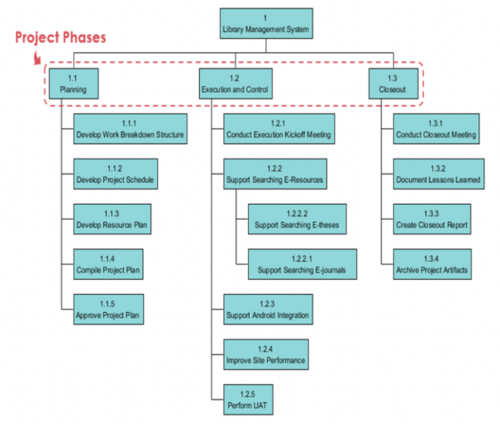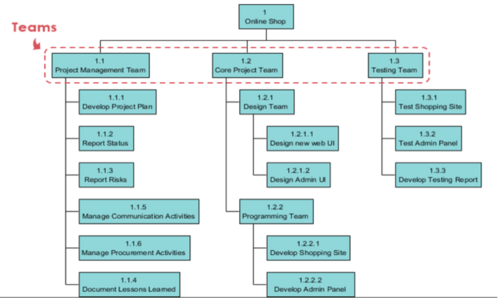Work Break Down Structure(WBS)
(→Preparation methods of creating a WBS) |
(→Preparation methods of creating a WBS) |
||
| Line 49: | Line 49: | ||
!WBS creation methods !! Advantages !! Disadvantages | !WBS creation methods !! Advantages !! Disadvantages | ||
|- | |- | ||
| − | | Top-down || • Convenient status reporting for structural | + | | Top-down || • Convenient status reporting for structural items• Ensure the logical structure of the project• Whether there is value in brainstorming/discovering project deliverables•Can accommodate additional deliverables as they are discovered || • Need constant attention, don't neglect any work package• The WBS needs to be refined to a level of detail enough to allow for management |
| − | + | ||
| − | + | ||
| − | + | ||
| − | || | + | |
|- | |- | ||
| Example || Example || Example | | Example || Example || Example | ||
Revision as of 08:27, 9 April 2023
"Developed by Qian Xiao“
Contents |
Abstract
Work break down structure is a project management tool that breaking down complex project into phases, deliverables and work packages. A WBS can integrate scope, cost and deliverables into a single tool and provides the necessary framework for detailed cost estimating and control along with providing guidance for schedule development and control. The following article aims to provide an overview of the basic concepts of WBS, the preparation of creating a WBS, and discussing the three different use cases with WBS, finally analysis the limitations of using WBS.
Introductions of WBS
Work break down structure (WBS) is defined as: "Deliverable oriented hierarchical decomposition of the work to be executed by the project time to accomplish the project objectives and create the required deliverables.” by the Project Management Institute (PMI). For project, it is one of the most important project management tools that integrates scope, cost and schedule baselines ensuring that project plans are in alignment. And the project can be planned, executed, controlled, monitored, and reported effectively with this tool.
Elements of WBS
Work break down structure is made up of three elements, which are work, breakdown and structure.
- Work: tasks that can produce tangible results;
- Breakdown: a hierarchical structure of progressive subdivision and classification;
- Structure: organization of the sections according to a certain pattern.
Types of WBS
Here are three main types of WBS: 1) Deliverable-Based, 2) Phase-Based and 3) Responsibility-Based. And the main difference between the two approaches are the elements identified in the first level of WBS.
- A deliverable-based work breakdown structure clearly demonstrates the relationship between the project deliverables (i.e., products, services, or results) and the scope (i.e., work to be executed). From figure 1(a), the level 1 elements are summary deliverable descriptions, while level 2 elements in each leg of the WBS are all the unique deliverables required to create the respective level 1 deliverable.
- A phase-based WBS clearly demonstrates the process of a project. From figure 1 (b), each element of level 1 is typical phases of a project, while the level 2 elements are the unique deliverables in each phase. This kind of WBS type requires work associated with multiple elements be divided into the work unique to each level 1 element.
- A responsibility- based WBS clearly defines project activities based on the organization units that will work on the project. This structure allows the responsibilities involved in the project management process to be assigned to each member.
Features of WBS
The WBS represents a specific description of the project deliverables and scope. It is not a statement of how or when the deliverables will be produced, but rather a refinement and description of the project outputs and scope. It has the following features:
- Supporting the definition of all work required to achieve outputs, objectives, deliverables, or specific outcomes.
- The hierarchical structure used to describe and define the deliverables, and which is established in a “parent-child” relationship.
- Having an objective or specific result, which is known as a deliverable or output.
Importance of WBS
In the execution of the project, there will be found a variety of problems that will lead to disadvantageous impacts on the project target. Many factors lead to several project stumbling blocks, such as over budget, delayed projects, poor quality, and rework. These problems affect the project objectives of cost, quality, and time of project[3]. A constructed WBS can result in the following outcomes:
- Clear work assignments, goals, objectives, and deliverables.
- Scope can be fixed and manageable.
- Budget can be under control.
- Deadline can be meet.
Preparation methods of creating a WBS
When creating a WBS, here are several methods that can be used for creating a WBS. These included outlines and organization charts, fishbone, and brainstorming techniques, top-down and bottom-up development strategies. And WBS templates are available and corporate guidelines or standards can be referenced or copied for quick-starting WBS development[6].
It should be based on the specific project aim, requirements, assumptions, and constraints to choose an appropriate method. The following table highlights some advantages and disadvantages of the above-mentioned methods.
| WBS creation methods | Advantages | Disadvantages |
|---|---|---|
| Top-down | • Convenient status reporting for structural items• Ensure the logical structure of the project• Whether there is value in brainstorming/discovering project deliverables•Can accommodate additional deliverables as they are discovered | • Need constant attention, don't neglect any work package• The WBS needs to be refined to a level of detail enough to allow for management |
| Example | Example | Example |
| Example | Example | Example |
Annotated Bibliography
Project Management Institute. “A Guide to the Project Management Body of Knowledge (PMBOK® Guide)”- Sixth Edition, 2017 The PMBOK Guide is the guide to Body Of Knowledge within Project management, providing widely accepted standards and guide in the use of them. It covers most aspects within project management, although PMI, the publisher, realizes that no book can contain the whole Body of knowledge. This comes clear when the reader looks for motivation in a team, or goal setting techniques. Still, the PMBOK recognizes the importance of both.
References
Cite error: Closing </ref> missing for <ref> tag


